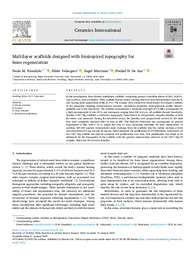Título :
Multilayer scaffolds designed with bioinspired topography for bone regeneration |
Autor :
Riosalido, Paula M. 
Velásquez, Pablo
Murciano Cases, Ángel 
De Aza, Piedad  |
Editor :
Elsevier |
Departamento:
Departamentos de la UMH::Ciencia de Materiales, Óptica y Tecnología Electrónica |
Fecha de publicación:
2025 |
URI :
https://hdl.handle.net/11000/35721 |
Resumen :
In this investigation, three distinct multiphasic scaffolds, comprising primary crystalline phases of SiO₂, Ca₂P₂O₇, and Ca₃(PO₄)₂, were developed. These scaffolds feature surface coatings that have been functionalised with Na, K, and varying molar proportions of Mg (0–1%). The samples were extensively characterised to evaluate a number of key properties including microstructure, porosity, mechanical properties, biodegradation profile, biocompatibility and in vitro bioactivity. The scaffolds demonstrated a mechanical strength of 1.8 MPa, accompanied by a high macroporosity of over 85 % and micropores ranging from 200 to 6 μm. All scaffolds showed bioactivity. Notably, CS0.7 Mg exhibited a distinctive topography characterised by non-periodic, irregular lamellae at both the micro- and nanoscale. During the bioactivity assays, the lamellae were progressively covered by HA until they were completely obscured after 14 days in SBF. This bioactive behaviour was accompanied by gradual degradation in PBS, with a 15 % weight loss over 21 days, indicating suitability for bone regeneration. In addition, ICP-OES analysis demonstrated ionic exchange from the scaffolds into the culture medium at both concentrations of 15 mg/mL and 30 mg/mL, which promoted the proliferation of 3T3 fibroblasts. Cells seeded on the CS0.7 Mg scaffold also showed sustained cell proliferation over time. This proliferation was found to be influenced by the topography of the scaffold, with the greatest enhancement observed in the CS0.7 Mg-7D samples, which had HA-covered lamellae.
|
Palabras clave/Materias:
Sol-gel processes
Porosity
Glass ceramics
Biomedical applications |
Área de conocimiento :
CDU: Ciencias aplicadas: Ingeniería. Tecnología |
Tipo de documento :
info:eu-repo/semantics/article |
Derechos de acceso:
info:eu-repo/semantics/openAccess |
DOI :
https://doi.org/10.1016/j.ceramint.2025.01.180 |
Publicado en:
Ceramics International |
Aparece en las colecciones:
Artículos - Ciencia de los materiales, óptica y tecnología electrónica
|
 La licencia se describe como: Atribución-NonComercial-NoDerivada 4.0 Internacional.
La licencia se describe como: Atribución-NonComercial-NoDerivada 4.0 Internacional.
.png)
